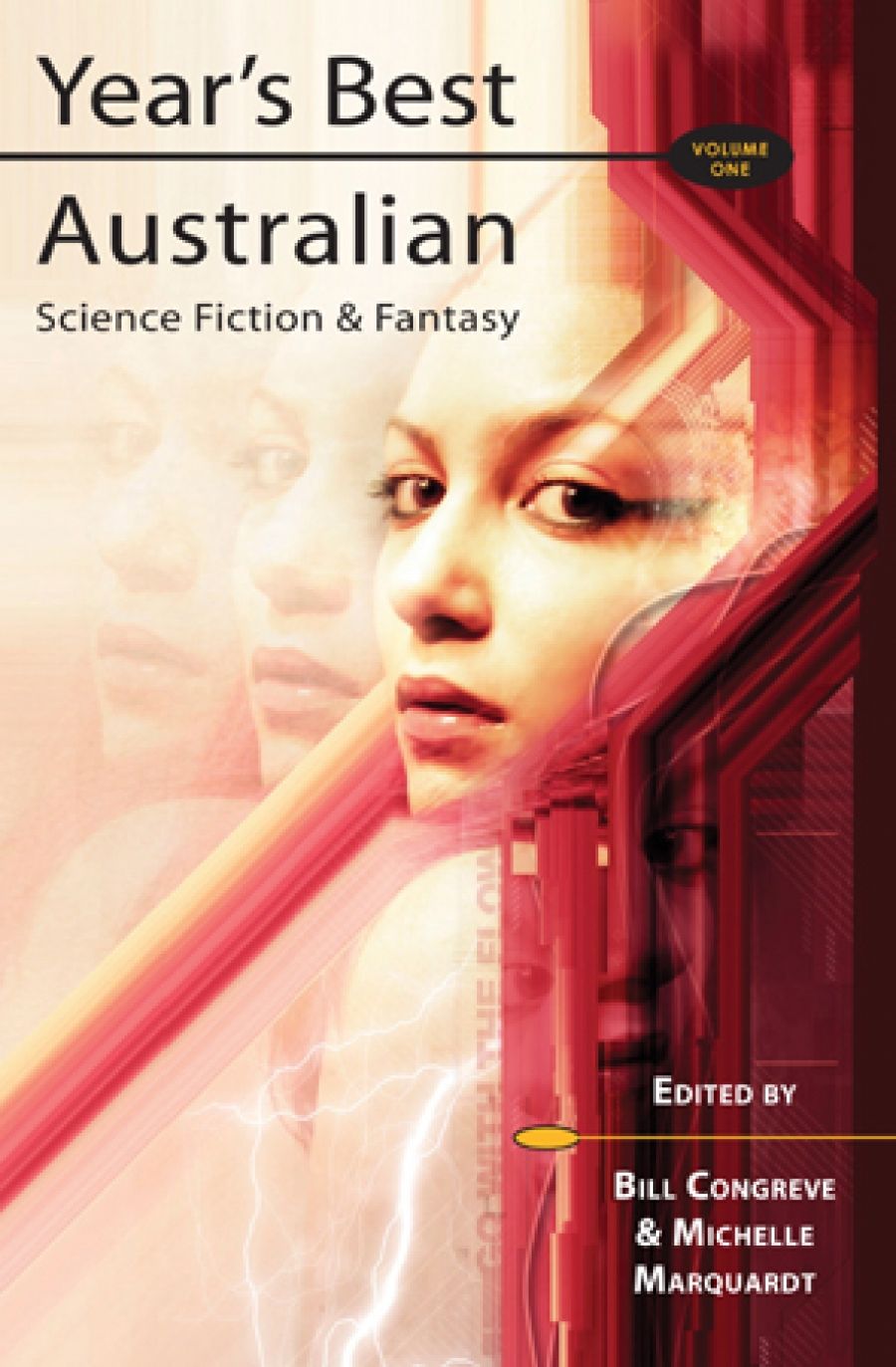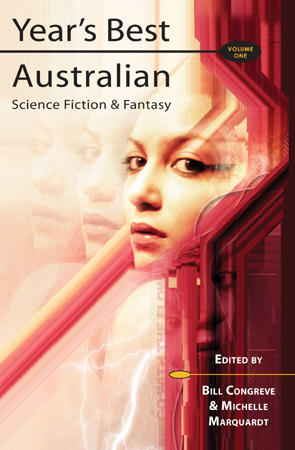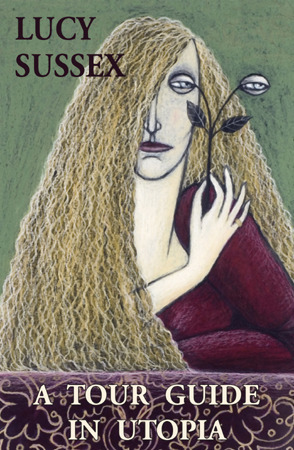
- Free Article: No
- Contents Category: Australian Fiction
- Review Article: Yes
- Article Title: A small fantastic pond
- Online Only: No
- Custom Highlight Text:
The useful introduction to The Best Australian Science Fiction and Fantasy 2004 (the first volume in an intended new series) gives an idea of the less than adequate state of genre publishing in Australia. For the moment, it seems that science fiction (SF) authors in particular are mainly confined to semi-professional magazines and small presses, or are obliged to seek international markets for their work. Though the editors understandably do not say so, the fact of a small pond necessarily produces some relaxation of expectations. There is much amateurish writing in this collection, and a more serious lack of urgency: many contributors seem less interested in creating new myths than amusing themselves with borrowed ones, like fans dressing up for a convention.
- Book 1 Title: The Year's Best Australian Science Fiction and Fantasy 2004
- Book 1 Subtitle: Volume One
- Book 1 Biblio: MirrorDanse, $19.95 pb, 249 pp, 0975773607
- Book 1 Cover Small (400 x 600):

- Book 1 Cover (800 x 1200):

- Book 2 Title: A Tour Guide in Utopia
- Book 2 Subtitle: Stories by Lucy Sussex
- Book 2 Biblio: MirrorDanse, $24.95 pb, 268 pp, 0975785206
- Book 2 Cover Small (400 x 600):

- Book 2 Cover (800 x 1200):

Another option is parody: Brendan D. Carson’s ‘Occam’s Razing’ and Brendan Duffy’s ‘The Tale of Enis Cash, Smallgoods Smokehand’ are heavy jokes at the expense of their mock-medieval settings, reduced to silliness by Australian scepticism. Terry Dowling’s ‘Flashmen’ shows much more skill, but remains just as facetiously distanced from its hard-boiled idiom: by the end, we grasp that Dowling’s heroes and monsters are equally simulacra, but references to Sergio Leone probably weren’t needed to underline the point.
A couple of stories deserve special mention: in particular, Margo Lanagan’s tender and horrific ‘Singing My Sister Down’, which the editors justly single out as the highlight of the collection. Although it would be unfair to divulge the memorable premise, one can safely praise Lanagan’s rhetorical control and bowerbird knack for details (songs, place names, technologies), which render the unspecified pre-industrial setting both archetypal and strange. Lanagan has a special gift for bizarre initiation rituals, one juncture where fantasy intersects with the young adult genre in which she mostly writes; but her best stories, like this one, are less straightforward coming-of-age allegories than experiments in feeling, visions elaborated for their own sake rather than fully understood in advance. Adult readers need not feel patronised, despite the presence of an all-wise ‘Mumma’ who personifies the residual hand-holding technique, the author looking on protectively while the young narrator fumbles for expression.
The other wild card in the collection is Ben Peek’s ambitious ‘The Dreaming City’, announced as part one of a larger project: a grandiose attempt at a new myth of Sydney, based on historical research documented in straight-faced footnotes (maybe an appendix would do the job better in his envisaged novel). Here, the starting point is the late-career trip to Sydney by celebrity lecturer Mark Twain, who finds himself guided through the lower depths by Peek’s surrogate – a kind of supernatural political entrepreneur, who hopes to use Twain’s cultural capital to underwrite his revolution. On this showing, Peek has ideas, of the kind that would go down well at an interdisciplinary conference, but not the deep interest in character or language that would entirely bring the phantasmagoria to life. Still, I look forward to further instalments.
A comparably academic approach limits Lucy Sussex’s ancestor-haunted new collection, A Tour Guide in Utopia, despite the author’s obvious intelligence. Sussex has a day job as a critic and literary researcher and writes more often than not in the margins of other people’s work, envisaging ‘Waltzing Matilda’ as a serial killer narrative, or the mad wife from Jane Eyre as a disquieting feminist guardian angel (luckily, a Brontë specialist is on hand to provide explanations and a reading list). This kind of studied irreverence has a family tree of its own – going back, for instance, to Angela Carter – but Sussex’s approach to the past is distinctively cool and pragmatic, in line with her exemplary heroes, the postmodern Aboriginal tribe of ‘Runaways’. For her, tradition is a junk heap to be raided for objects that can be turned to new uses, though trash proves rarely wholly separable from treasure.
The price of this coolness is a certain loss of immediacy: in Sussex’s work (unlike Lanagan’s), reason rather than emotion seems to dominate, as if the author were putting herself through the paces of the SF and horror genres without quite believing in the ritual’s power. With their fatal knowingness about narrative-as-ideology, the stories threaten to turn into a species of literary criticism, and sometimes do. Ghosts and flashbacks notwithstanding, the past is understood as available mainly through its material traces, a body of texts, artefacts and received myths – a point made most explicitly in a virtual-reality fantasia about Heisenberg, too cutely titled ‘Absolute Uncertainty’.
Personally, I found it harder to forgive Sussex for the similar icon-shuffling game played in ‘Kay and Phil’, where the cardboard portrait of Philip K. Dick suggests Tim Burton’s Ed Wood without the affection – the amphetamine-fuelled pulp author typing through the small hours, consulting the I-Ching, and feebly telling himself ‘I don’t hate women’. While feminist suspicion of Dick is understandable, the bald accusation of misogyny (which Sussex has made explicit elsewhere) does less than justice to his honestly expressed anguish about non-communication between the sexes, one crucial, though not always recognised, aspect of his famous ‘solipsism’. Sussex hints at this, but has her eye mainly on a non-fictional thesis regarding parallels between Dick’s The Man in the High Castle (1962) and Katherine Burdekin’s earlier Nazi dystopia Swastika Night (1936; written as Murray Constantine); the rudimentary dream conceit of the tale looks especially thin next to Dick’s own zany procedures, which are neither recreated nor parodied with any conviction.
For all the piling-up of allusions, direct literary pastiche is surprisingly absent from this collection (clearly not for want of skill, given that Sussex did a credible job of sounding nineteenth century in parts of her novel The Scarlet Rider, 1996). Dominating these pages is Sussex’s own storytelling voice – brightly colloquial, modern and knowing, if a bit too fond of its own puns and of uplifting sentiments (traits both illustrated in the dreadful last paragraph of ‘The Queen of Erewhon’). Generally, Sussex is at her weakest when ‘celebrating’ the capacity of cultures to renew themselves, an optimistic pose that again rings slightly false.
In the stronger stories, the re-emergence of the past in the present points a simpler moral, as in ‘Frozen Charlottes’, where a couple renovating their inner-suburban cottage find themselves unearthing one memento mori after another. More simply still, in ‘The Gloaming’, an idyllic Melbourne landscape of joggers and picnickers is darkened by intimations of what lies beneath:
The shadows around me were thickening, with patches here and there dark as night already. Trick of the light, maybe, or my old eyes, but they seemed still only when you looked at them directly. If you took your gaze away, they pulsed like living things, ready to leap out and engulf the world.
Even in Utopia, death holds sway.


Comments powered by CComment